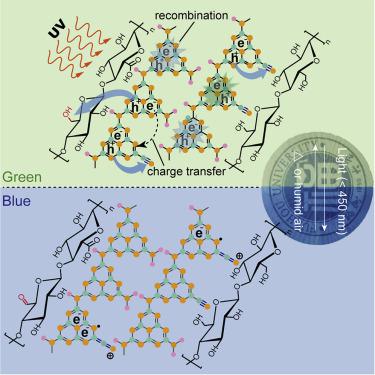Cell Reports Physical Science ( IF 8.9 ) Pub Date : 2021-07-30 , DOI: 10.1016/j.xcrp.2021.100516 Hongrui Cheng 1, 2 , Wenhao Sun 1, 2 , Yongfeng Lu 1, 2 , Haohong Li 1 , Wenyue Su 1 , Jing Zhang 1 , Tailiang Guo 1, 2 , Fushan Li 1, 2 , Paul S. Francis 3 , Yuanhui Zheng 1, 2

|
Plasmonic colors enabled by resonant hot electrons offer unique advantages in imaging, display, and optical encryption applications. Although metasurfaces can show full colors with sub-wavelength spatial resolutions, it is challenging for them to generate dynamic colors. Herein, we report an approach to dynamically control the color of semiconducting nanoparticles with plasmonic properties by tuning their hot-electron lifetime from timescales of seconds to days. The color switch is realized by storing photogenerated electrons, which produce plasmons upon light excitation, in carbon nitride. A photochromic display based on long-lived hot electrons is demonstrated. Two-dimensional patterns with unlimited designs and feature sizes from micro- to macro-scale are generated through laser writing or photolithography and then can be erased by exposure to moisture or heat, hundreds of times without obvious destruction to the device. This work may expand the possibilities of using hot electrons for reversibly manipulating the colors of semiconductor nanoparticles with plasmonic properties.
中文翻译:

超长寿命氮化碳中的热电子及其在可逆动态彩色显示器中的应用
由共振热电子启用的等离子颜色在成像、显示和光学加密应用中具有独特的优势。尽管超表面可以显示具有亚波长空间分辨率的全色,但它们生成动态颜色具有挑战性。在此,我们报告了一种通过将热电子寿命从几秒到几天进行调整来动态控制具有等离子体特性的半导体纳米粒子颜色的方法。颜色切换是通过将光生电子存储在氮化碳中来实现的,光生电子在光激发时会产生等离子体。展示了基于长寿命热电子的光致变色显示器。通过激光写入或光刻生成具有无限设计和从微观尺度到宏观尺度的特征尺寸的二维图案,然后可以通过暴露在湿气或热量中进行数百次擦除,而不会对器件造成明显破坏。这项工作可能会扩大使用热电子可逆地操纵具有等离子体特性的半导体纳米粒子的颜色的可能性。



























 京公网安备 11010802027423号
京公网安备 11010802027423号